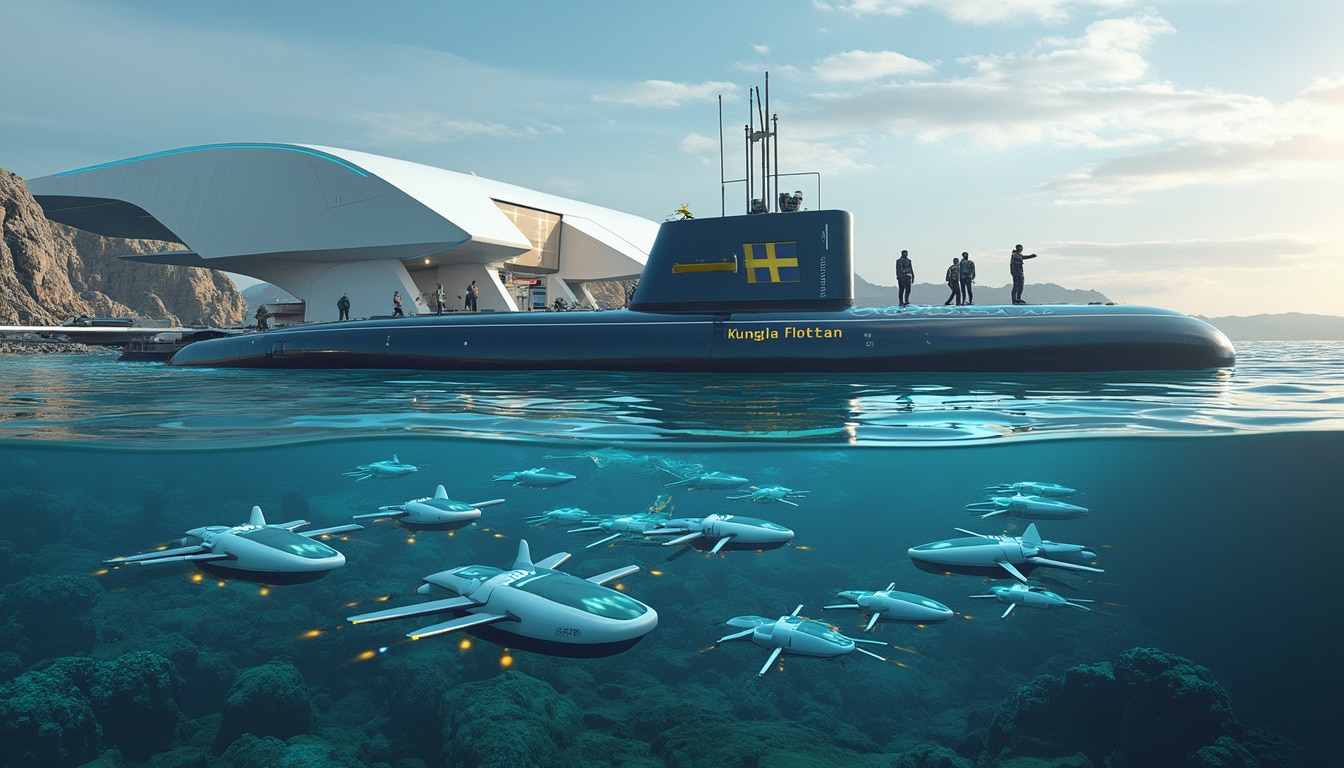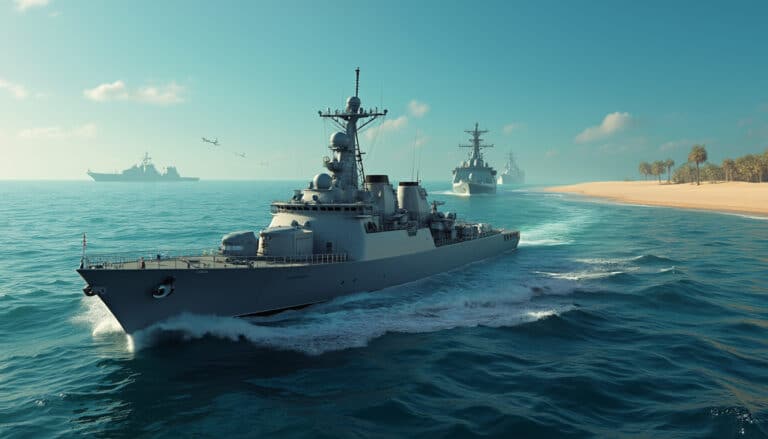Sweden is resolutely committed to underwater innovation.Saab, a leader in defense technologies, is strengthening its naval capabilities.A new contract marks the beginning of an advanced technological era.
In 2024, research on underwater technologies such as mine countermeasures and submarine-related systems will be a national priority. Saab has recently signed an agreement with the Swedish defense procurement agency to develop innovative concepts aimed at enhancing underwater capabilities. This initiative is part of a long-term plan to secure Sweden’s underwater capabilities. The studies will focus on various concepts and technologies, anticipating future needs in this strategic domain. At the same time, the results of this research will inform ongoing efforts for the construction of new Type A26 submarines. In light of Sweden’s potential accession to NATO, its expertise in navigating the Baltic Sea becomes a crucial asset. Finally, the anticipated acquisition of lightweight autonomous underwater vehicles demonstrates the country’s commitment to modernizing its underwater operations.

In 2024, the Swedish armed forces are embarking on an ambitious initiative to strengthen their expertise in underwater technology. This approach is set against a changing geopolitical context, where mastery of aquatic environments becomes crucial for national security and international alliances. Discover how Sweden is equipping itself to navigate and secure its waters in the years to come.
Table des matières
ToggleWhat is Sweden’s new strategic direction regarding underwater technologies?
Sweden, aware of the strategic stakes related to maritime environments, has decided to prioritize research and development of advanced underwater technologies for the year 2024. This strategic direction aims to enhance anti-mine capabilities and develop systems related to submarines.
According to Conal Walker, spokesman for Saab, an important Swedish defense contractor, this contract with the national defense procurement agency represents a key milestone in a long-term plan. “Saab will examine the needs and possibilities for the future underwater domain, including various concepts and technologies related to current and future capabilities,” he told Defense News.
This initiative includes the study of new technologies to strengthen the existing capabilities of the Swedish navy and anticipate future challenges. At the same time, this research could also benefit the development of the new submarines that Saab is preparing to deliver to the Swedish navy.
What does the contract signed between Saab and the Swedish defense procurement agency entail?
The contract signed in December 2022 between Saab and the Swedish defense procurement agency involves studies for the development of concepts for new underwater technologies. The main objective is to secure Sweden’s underwater capabilities in the long term.
This collaboration will allow Saab to conduct in-depth research on future needs and technological opportunities in the underwater domain. The focus will be on diversifying current capabilities and integrating emerging technologies, such as unmanned underwater vehicles and advanced detection systems.
These studies are crucial for the success of Sweden’s new submarine program, scheduled to be delivered between 2027 and 2028, after several delays initially anticipated for this year. These submarines will offer enhanced capabilities for underwater operations, including the deployment of autonomous underwater vehicles and special forces.
What geopolitical challenges motivate these technological developments?
Sweden’s geographical position, bordered by the Baltic Sea, places it in a vulnerable region facing tensions with Russia, making mastery of underwater environments a strategic priority. Sweden’s potential accession to NATO would reinforce this necessity, allowing Stockholm to contribute effectively to allied operations in this strategic area.
With five currently operational diesel-electric submarines, the modernization of the fleet and the introduction of new types of submarines significantly enhance Sweden’s capacity to secure its territorial waters. These new submarines will be equipped to launch autonomous underwater vehicles, thereby improving underwater operations and strategic deterrence.
By strengthening its underwater capabilities, Sweden is also positioning itself as a key player in protecting vital maritime routes and responding to potential threats, such as naval mines and enemy incursions.
How does Saab contribute to strengthening Sweden’s underwater capabilities?
Saab plays a central role in the development of new underwater technologies for Sweden. In addition to signing the contract for concept studies, the company is also involved in the construction of new Type A26 submarines.
The Type A26 program, launched in 2015, aims to build two new submarines for the Swedish navy. These submarines, expected to enter service between 2027 and 2028, are designed to be quieter, stealthier, and more efficient than their predecessors. They will be capable of launching autonomous underwater vehicles, providing increased operational capability and better tactical flexibility.
The delays encountered in the Type A26 program have prompted Saab to accelerate its research and development efforts to ensure that the new submarines meet modern requirements for underwater warfare and maritime security. Saab is also continuing to collaborate with international partners to integrate the latest technological innovations into these new submarines.
What are the benefits of new underwater technologies for the Swedish navy?
The new underwater technologies developed by Saab and other industry players offer several significant advantages for the Swedish navy. Among these advantages are improved capabilities for mine detection and neutralization, as well as increased stealth and efficiency of submarines.
Autonomous underwater vehicles, for example, can conduct reconnaissance and surveillance missions without putting naval personnel at risk. Furthermore, these technologies allow for better integration of communication and detection systems, thereby enhancing the coordination of underwater operations.
Another key advantage is the ability to deploy special forces from submarines, providing increased strategic flexibility for sabotage or reconnaissance missions in hostile waters. These technological advancements bolster Sweden’s position as a nation capable of protecting its maritime interests in an increasingly complex environment.
What challenges must Sweden face in the development of these technologies?
The development of advanced underwater technologies presents several challenges for Sweden. One of the main obstacles is the high cost associated with the research and development of sophisticated systems. Ongoing funding and budget management are essential to ensure the success of long-term projects.
Another major challenge is the need to maintain a high level of technical expertise. Training and recruiting qualified personnel in the field of underwater technologies are crucial to ensure the effective development and deployment of these systems.
Moreover, coordination with international partners, particularly in the context of a potential accession to NATO, requires harmonization of standards and operational practices. Collaboration with foreign companies and defense organizations is essential to leverage global innovations and best practices.
What role does international cooperation play in these technological developments?
International cooperation is a key element in strengthening Sweden’s underwater capabilities. By collaborating with NATO partners and other allies, Sweden can benefit from an exchange of knowledge and advanced technologies, accelerating the development of its own underwater systems.
Moreover, this collaboration allows participation in joint military exercises and peacekeeping operations, thereby strengthening Sweden’s ability to operate effectively in multinational environments. Participation in international projects also increases Sweden’s visibility and credibility in the field of underwater defense.
Additionally, partnerships with international technology companies, such as Anduril or BAE Systems, allow Sweden to integrate cutting-edge innovations into its own developments, ensuring that its underwater capabilities remain at the forefront of technology.
What are the implications for national and regional security?
Strengthening Sweden’s underwater capabilities has significant implications for national and regional security. By improving its underwater technologies, Sweden is better equipped to protect its territorial waters against potential threats, such as enemy incursions or naval mine attacks.
This technological advancement also strengthens Sweden’s strategic position in the Baltic Sea region, a geopolitical hotspot where military presence is crucial for maintaining the balance of power. Sweden’s ability to detect and neutralize underwater threats contributes to the stability and security of this vital area.
Furthermore, in the event of accession to NATO, Sweden could contribute valuable expertise in navigation and underwater warfare in the Baltic Sea, thereby enhancing the alliance’s collective capabilities in the face of challenges posed by regional actors.
How do technological innovations support Sweden’s overall strategy?
Underwater technological innovations are at the heart of Sweden’s overall defense strategy. By investing in advanced systems, Sweden ensures it has the necessary tools to effectively respond to current and future threats in the maritime domain.
For example, the acquisition of new military deployment and armament capabilities enhances the versatility and responsiveness of naval forces. These innovations facilitate the implementation of modern tactics, such as advanced reconnaissance missions and rapid threat neutralization operations.
Moreover, collaboration with international actors and the integration of technologies such as underwater drones, like Copperhead from Anduril, strengthen Sweden’s ability to maintain technological superiority in the underwater domain.
These innovations also support a proactive defense approach, enabling Sweden to take preventive measures rather than reactive ones against potential threats.
What are the future prospects for Swedish underwater technologies?
The future prospects for underwater technologies in Sweden are promising, with many ongoing and upcoming projects aimed at maintaining and strengthening the nation’s position in this strategic field.
In 2024, the priority given to underwater technology research will pave the way for new innovations and significant advancements. The concept studies conducted by Saab are the first steps in a continuous process of improvement and modernization of underwater capabilities.
The introduction of new Type A26 submarines and autonomous underwater vehicles represents a major breakthrough, allowing Sweden to respond more effectively and flexibly to the complex challenges of underwater warfare. These technologies will not only strengthen national defense but also support international maritime security efforts.
Additionally, future projects, such as initiatives by Def Tech, will continue to celebrate and strengthen two decades of innovation and technological excellence in Sweden, thus ensuring continuity in the development of underwater capabilities.
With a clear vision and sustained investments, Sweden is well-positioned to remain at the forefront of underwater technology, thereby ensuring enhanced security and increased influence in international maritime affairs.






















